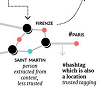Towards place-based exploration of Instagram: Using co-design to develop an interdisciplinary geovisualization prototype
Keywords:
Instagram, geovisualization, cultural routes, social media, text mining, spatial analysis, co-occurrence graphs, co-design, interfaces, deep mapsAbstract
An abundance of geographic information is hidden within texts and multimedia objects that has the potential to enrich our knowledge about the relationship between people and places. One such example is the geographic information embedded within user-generated content collected and curated by the social media giants. Such geographic data can be encoded either explicitly as geotags or implicitly as geographical references expressed as texts that comprise part of a title or image caption. To use such data for knowledge building there is a need for new mapping interfaces. These interfaces should support both data integration and visualization, and geographical exploration with open-ended discovery. Based on a user scenario on the Via Francigena (a significant European cultural route), we set out to adapt an existing humanities interface to support social and spatial exploration of how the route is perceived. Our dataset was derived from Instagram. We adopted a thinking by doing approach to co-design an interdisciplinary prototype and discuss the six stages of activity, beginning with the definition of the use case and ending in experimentation with a working technology prototype. Through reflection on the process of tool modification and an in-depth exploration of the data encoding, we were better able to understand the strengths and limitations of the data, the tool, and the underlying workflows. This in-depth knowledge helped us to define a set of requirements for tools and data that will serve as a valuable contribution for those engaged in the design of deep mapping interfaces for place-based research.

Downloads
Published
Issue
Section
License
Copyright (c) 2018 Catherine Emma Jones, Daniele Guido, Marta Severo

This work is licensed under a Creative Commons Attribution 4.0 International License.
Articles in JOSIS are licensed under a Creative Commons Attribution 3.0 License.
